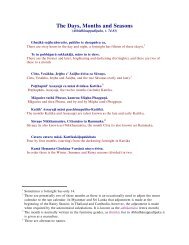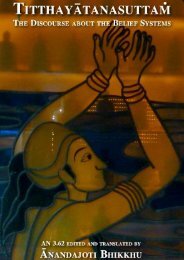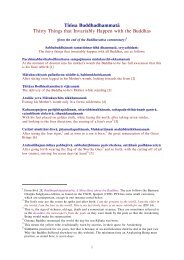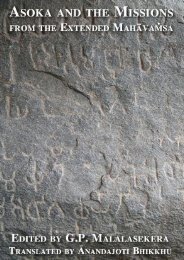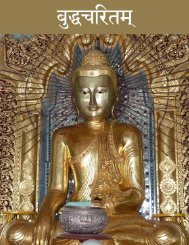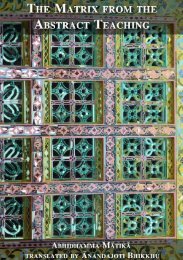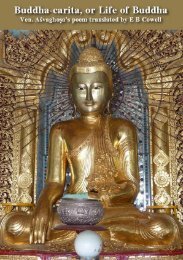Light on the Pronunciation of Pali
Light on the Pronunciation of Pali
Light on the Pronunciation of Pali
You also want an ePaper? Increase the reach of your titles
YUMPU automatically turns print PDFs into web optimized ePapers that Google loves.
muddhajo ṭu-kāro eva bhaveyya.<br />
it will be -ṭu-character, a cerebral.<br />
Evañ-ca sati akkharavipatti nāma siyā.<br />
Thus, in this <strong>the</strong>re will surely be a wr<strong>on</strong>g letter (and sound).<br />
Esa nayo sesesu muddhajadantajesu.<br />
This is <strong>the</strong> method for <strong>the</strong> rest <strong>of</strong> <strong>the</strong> cerebrals and <strong>the</strong> dentals.<br />
Tasmā, kammavācaṁ sāventehi,<br />
Therefore, with <strong>the</strong> declarati<strong>on</strong>s <strong>of</strong> <strong>the</strong> legal acti<strong>on</strong>, 19<br />
nāma ṭhāna-karaṇa-payatanesu suṭṭhu kusalehi bhavitabban-ti.<br />
<strong>the</strong> positi<strong>on</strong>, articulati<strong>on</strong> and effort should surely be made skilfully. 20<br />
Sithilañ-ca dhanitañ-ca, dīghaṁ, rassaṁ, garuṁ, lahuṁ,<br />
Unvoiced and voiced, l<strong>on</strong>g, short, heavy, light,<br />
niggahītaṁ vimuttañ-ca sambandhañ-ca vavatthitaṁ.<br />
<strong>the</strong> restrained, <strong>the</strong> free, <strong>the</strong> c<strong>on</strong>junct and <strong>the</strong> separated.<br />
Mudunā vacīpayogena vattabbā vaggapaṭhama-tatiya-pañcamā sithilā nāma.<br />
The first in <strong>the</strong> group, <strong>the</strong> third and <strong>the</strong> fifth should be spoken with s<strong>of</strong>t applicati<strong>on</strong>, and are<br />
known as unvoiced. 21<br />
Thaddhena vacīpayogena vattabbā vaggadutiya-catutthā dhanitā nāma.<br />
The sec<strong>on</strong>d and fourth in <strong>the</strong> group should be spoken with firm applicati<strong>on</strong>, and are known as<br />
voiced. 22<br />
Dīgha-rassā pubbe vuttā.<br />
L<strong>on</strong>g and short are as described previously.<br />
Dīghā ceva saṁyogapubbā ca niggahītantā ca garukā nāma,<br />
L<strong>on</strong>g (vowels), c<strong>on</strong>junct (c<strong>on</strong>s<strong>on</strong>ants) and those with <strong>the</strong> (pure) nasal at <strong>the</strong> end are known as<br />
heavy,<br />
sesā lahukā nāma.<br />
<strong>the</strong> rest are known as light. 23<br />
Yathā saddasahito vāto mukhachiddena bahi anikkhamma nāsasotābhimukho hoti,<br />
Just as air and sound with an open mouth doesn't go out through <strong>the</strong> nostrils,<br />
tathā mukhaṁ avivaṭaṁ katvā vattabbaṁ, byañjanaṁ niggahītaṁ nāma.<br />
so you should speak without having opened <strong>the</strong> mouth, this is known as <strong>the</strong> (pure) nasal<br />
c<strong>on</strong>s<strong>on</strong>ant.<br />
19 These are <strong>the</strong> legal acti<strong>on</strong>s made by Buddhist m<strong>on</strong>astics sitting in sessi<strong>on</strong>.<br />
20 O<strong>the</strong>rwise <strong>the</strong> legal acti<strong>on</strong> may be c<strong>on</strong>sidered invalid.<br />
21 Or, unaspirated: ka ga ṅa; ca ja ña, etc.<br />
22 These are what we o<strong>the</strong>rwise call aspirates, as in kha, gha; cha, jha, etc.<br />
23 Heavy and light are not <strong>the</strong> same as l<strong>on</strong>g and short, as a short may become heavy if<br />
followed by a c<strong>on</strong>s<strong>on</strong>ant cluster or a (pure) nasal. This distincti<strong>on</strong> is important for <strong>the</strong><br />
prosody <strong>of</strong> <strong>the</strong> texts.




